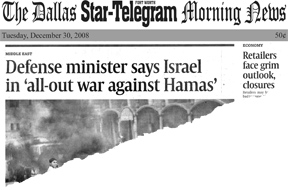In an industry fighting for its life, two North Texas dailies have reached a partial détente.
By DAN MCGRAW
Sitting at his desk at the Fort Worth Star-Telegram on Nov. 22, 1963, future CBS newsman Bob Schieffer fielded a strange phone call: A woman was asking for a ride to the Dallas police station. Schieffer, who covered the local police beat, explained that the paper was not in the taxi business, and besides, the president had been shot. The woman then explained that she was Lee Harvey Oswald’s mother.
Schieffer picked her up and raced to Dallas. Police detectives thought he was one of them, and so he sat in a room with Marguerite Oswald – and with a telephone. He phoned in scoops to Fort Worth on the assassination, and the Star-Telegram published four special editions that day.
The Fort Worth paper was beating The Dallas Morning News and Dallas Times-Herald on the biggest story of the century. It was a time when journalists relished competition, when being first and right was what they lived for. Beating the Dallas papers made it even better.
In 1991, the Times-Herald folded, ending one longstanding North Texas newspaper war. In the years before and since then, the nature of the News-vs.-Star-T competition has gone through shifts. Back in the late 1980s and early 1990s, the real fight was in the Mid-Cities and Arlington. In recent years both papers have retreated to their own sides of the Metroplex, and head-to-head competition, for the most part, has been limited to state news, sports coverage, and the local arts scene.
All that may change this year due to the financial woes in the news industry. The two major remaining North Texas dailies, despite having different corporate owners, have begun sharing content, with stories by writers on certain beats appearing in both papers. But this shared content agreement between competing media companies in the same media market is raising red flags. Some question whether the agreement may violate federal antitrust laws.
“This is highly unusual for two rivals to be working together,” said Texas Christian University journalism professor John Tisdale. “I understand the business model is not working right now, and that model has to be changed. Both papers have had staff reductions, and the amount of news they produce has suffered. But I really think sharing content will make the product worse, and eventually people in this area will suffer.
“I would really like to get inside their heads on this one,” Tisdale said. “I’d like to pick their brains. Because things really must have gotten horrible at both papers to consider a move like this.”
Getting inside their heads is tough right now. Dallas Morning News executive editor Bob Mong, in an e-mail, said he might talk to the Weekly “maybe in early February.”
Star-Telegram executive editor Jim Witt also declined to comment for this story, but publisher Gary Wortel did reply in an e-mail.
“The Star-Telegram and The Morning News are simply making some limited editorial content available to each other in a way we believe will benefit our readers,” Wortel wrote. “Currently this includes some photography, features, and sports coverage. This is similar to what many other papers are doing around the country, including papers in Washington, D.C. , Baltimore, Miami, and Fort Lauderdale.”
Last September, the papers entered into a joint distribution deal. The News delivery people are distributing about 5,000 daily and Sunday copies of the S-T in Dallas, Cook, Denton, and Ellis counties. The Fort Worth paper’s workers deliver about 20,000 daily and Sunday copies of the News to subscribers in Tarrant, Parker, Hood, and Johnson counties.
Massive layoffs and buyouts have decimated staffs in both newsrooms, particularly affecting arts coverage. The News no longer has a visual arts critic, and the S-T no longer has a theater critic or a classical music writer.
So when the S-T ran a review of Stage West’s production of “Code of the Woosters” last month, it was written by News theater critic Lawson Taitte and ran in both papers. S-T arts critic Gaile Robinson wrote about the Andy Warhol photo exhibit at TCU, and her story also ran in both papers. News classical music critic Scott Cantrell’s stories have been running in both. Photos from Dallas Cowboy football games have also been shared.
Local arts organizations have problems with this arrangement. Stage West producing director Jerry Russell thinks one critic will be stretched too thin in covering all theater productions in the Metroplex. But Russell also thinks the shared content will limit opinions in a cultural world that relies upon them.
“I hate this because we are going to have coverage limited to one opinion,” Russell said. “We have had shows where one reviewer adored it, and the other despised it. It is good to give the public this information. And, yes, there is a different viewpoint between what the audiences like in Dallas and Fort Worth. And the smaller theaters, those doing new experimental shows, are going to suffer.”
Todd Camp, who worked as an arts reporter for the S-T for 18 years before he took a buyout last year, calls the shared content plan “an extraordinarily bad idea.” Camp said the coverage of the arts scene is more than just reviewing shows. “You need a sense of history, you need to know the artistic merits of what they did in the past, and you need to know the business side and the cultural side.” He’s now the artistic director and founder of the Q Cinema film festival in Fort Worth.
“What I don’t understand is [the editors] keep saying local coverage must be the core of this new model,” Camp said. “I think the general assumption is that under this deal, the focus will be more on Dallas. The Fort Worth arts community will suffer, especially the smaller organizations.”
Coverage of professional sports is the next candidate for sharing. According to several sources, the papers may be pulling beat writers away from stadiums and arenas and sharing the writing and reporting of one reporter in each sport. Under the plan being considered, the News would no longer have a beat reporter for the Texas Rangers; the Dallas paper would get its coverage of the baseball team from the S-T. The opposite scenario would play out with the Dallas Mavericks and Dallas Stars – the News would cover those teams and share the resulting stories with the Fort Worth paper. Both papers would continue to cover the Dallas Cowboys and would share those articles and photos.
A sign that this will take place was the recent reassignment of the News’ Evan Grant to the Dallas Cowboys beat. Grant was the paper’s principal writer on the Rangers, and no one has replaced him. The reason for combining sports coverage is simple: cost. Travel expenses for a baseball writer can hit $50,000 per season, not to mention salary and benefits. Under the shared content agreement, four to eight sportswriters and editors at each paper could lose their jobs, the sources said.
Dallas Mavericks owner Mark Cuban called the sharing of coverage a “shame.” In an e-mail to the Weekly, Cuban said, “There is only so much a single beat writer can do or cover. Very often [S-T writer] Jeff [Caplan] and [News writer] Eddie [Sefko] find different sides of a story. Or they uncover unique perspectives that may have more of a local interest to their readers.”
Cuban has even proposed a plan on his blog that would shift the expense of newspaper sports coverage to the teams. He said the teams would pay for the coverage but without any editorial control. “We are happy to discuss contributing financially to retaining full coverage of the Mavs by both papers,” Cuban wrote. “There are better ways to solve this problem than just cutting costs. As a customer and reader of both papers, I wish they would have reached out before making their decision.”
By independent journalism standards, Cuban’s plan is very tricky, as Chesapeake Energy recently found out with its highly controversial (and now abandoned) Shale.TV project. But an even tougher trick might be getting the shared content arrangement past antitrust regulators. Federal law governs the way competing news media companies can combine business dealings, in order to prevent gouging of newspaper subscribers or ad customers.
In 1970, Congress passed the Newspaper Preservation Act (NPA), which allows newspapers in the same media market to combine business practices under what is called a joint operating agreement (JOA) and still be exempt from antitrust laws. Newspapers are considered to be under a JOA if they combine one or more business arrangements, from printing to sharing the same ad rates. Also included in that criteria is joint distribution.
But the law also states that papers that combine the business models can have “no merger, combination, or amalgamation of editorial or reportorial staffs, and that editorial policies be independently determined.”
In the opinion of several media antitrust experts, the current joint distribution deal and sharing of editorial content doesn’t quite cross the line. But further consolidation might. “It does raise some concerns,” said University of Wisconsin law professor Shubha Ghosh, an expert on media antitrust cases. “But you would have to prove who is harmed in this process. The readers probably are not, under the strict definition of the law. But if they start combining ad rates, competing media or those that buy the ads might have a case.”
Maxwell Blecher, a Los Angeles lawyer specializing in antitrust cases, said, “This has antitrust implications, sort of a mini-merger. But they appear to be doing it in a half-assed way so that they might avoid some of the antitrust laws.”
Blecher said there’s probably only one way the antitrust law will be enforced. “If you are a reporter who has lost your job because of this shared content deal, you might be able to prove you lost it because these papers are violating the antitrust laws,” he said.











